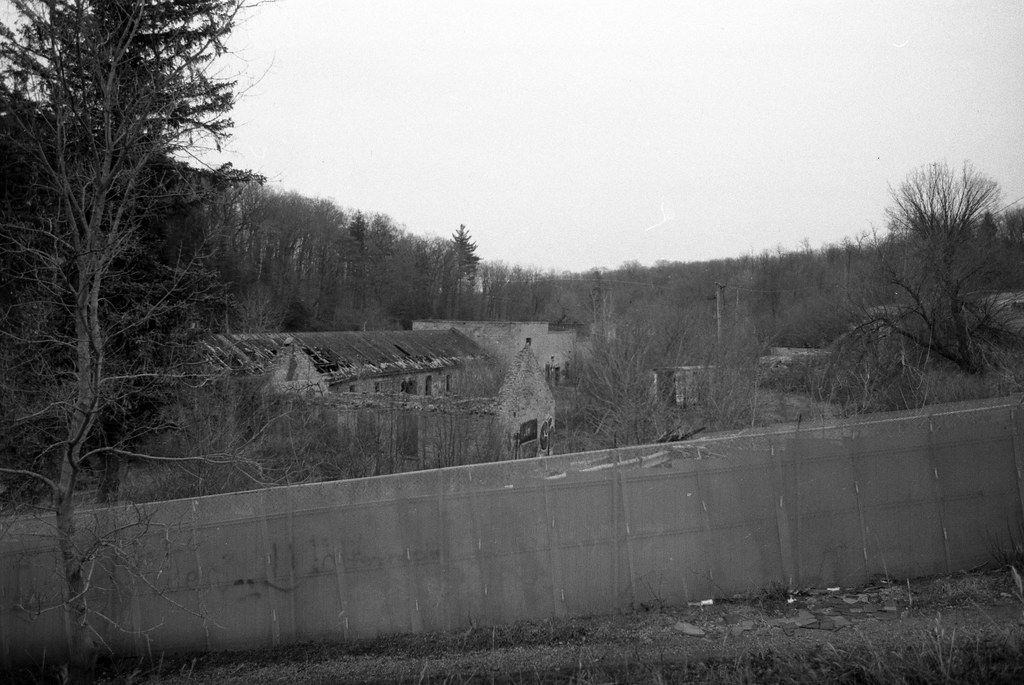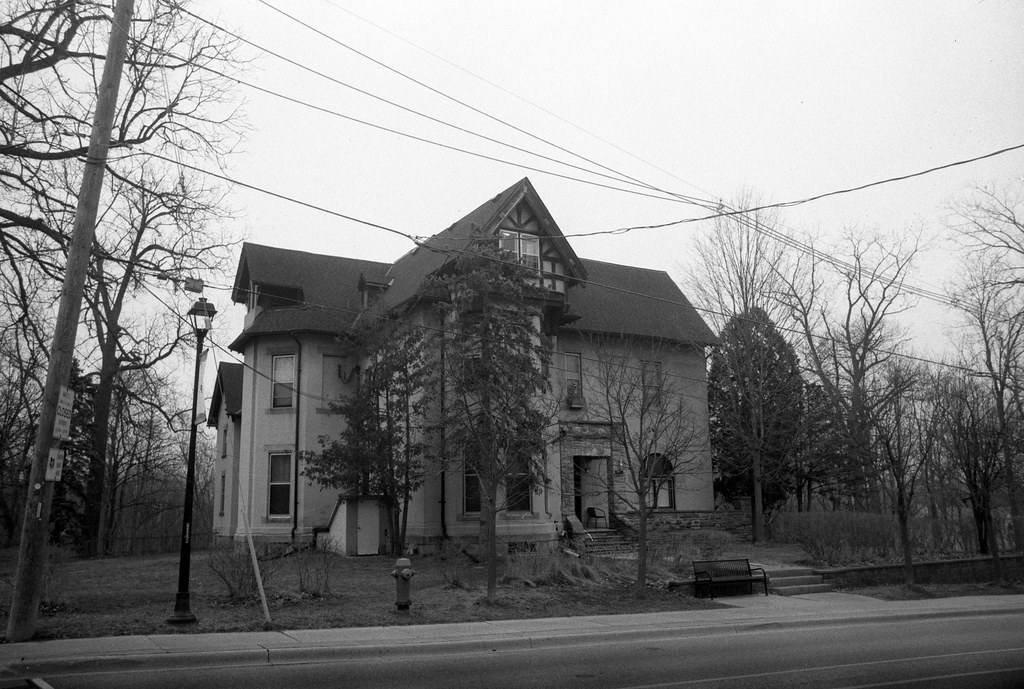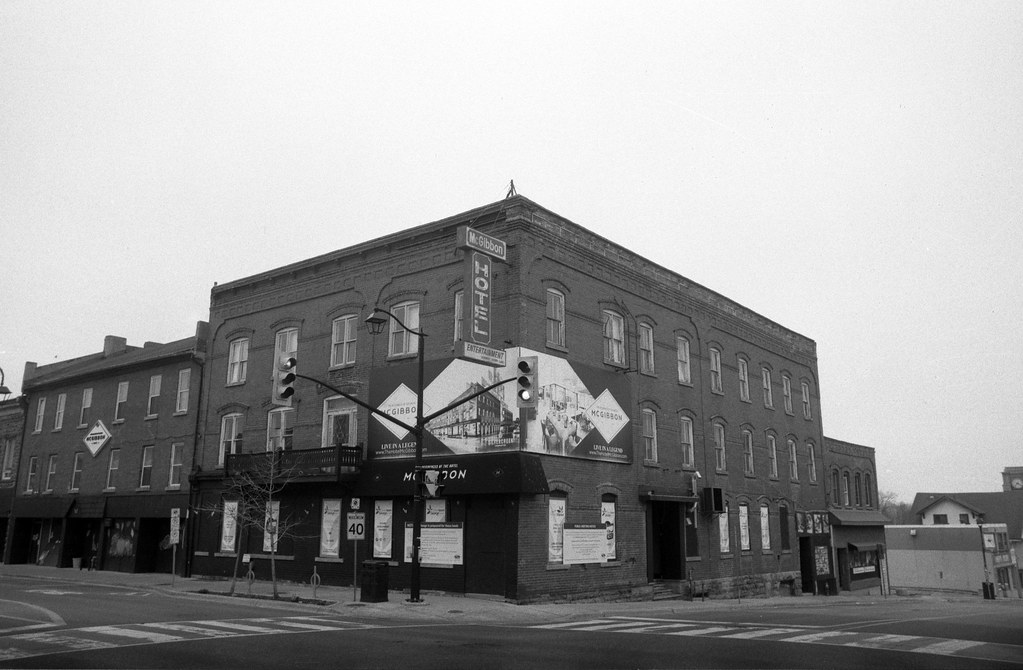Every time I can get out and shoot outside of Milton and Oakville, I get excited, especially when I can tell a new story. While Georgetown is rather compact, and the downtown is rather small. Georgetown presents a wide range of photographic opportunities. Until recently, most of my time in Georgetown has been spent in less-than-legal practices, namely exploring the abandoned Barber Mill (which is still easily accessed). But the downtown I recently discovered is rather photogenic, especially if you have a thing for churches; there are many of them for such a small area.

Nikon FM – AI Nikkor 28mm 1:3.5 – Fomapan 200 @ ASA-200 – Adox Atomal 49 (Stock) 10:00 @ 20C
The earliest known humans to settle along the banks of Silver Creek and the Credit River where Georgetown stands today were those of the Neutral Nation, followed by the Ojibwa after the deadly Beaver Wars wiped out the entire Neutral and Wendat peoples. It was the Ojibwa’s ancestors, which we know as the Mississauga’s of the Credit, who ceded their territory to the British Colonial Authorities following the Anglo-American War of 1812. Thomas Street and Abraham Nellis would be hired as surveyors to map out the newly acquired territories or townships. We visited Thomas Street’s community back in week two. Nellis would hire Charles Kennedy to survey the northern reaches of the Esquesing Township. As payment, Charles received a parcel of land along Silver Creek, which immediately attracted his four brothers, including George Kennedy. The Kennedy’s would all build mills, using Silver Creek as the power source, forming the core of a new settlement. When the Canada Company began their efforts to colonize further the western parts of Upper Canada, the York-Guelph Road (today Highway 7) ran directly through the Kenndey’s Mills which brought in plenty of new business to the small milling community. George would go on to build a woollens mill and foundry. The Barber family arrived in 1837, purchasing George’s foundry and woollens mill. They also established a post office, naming the community Georgetown after George Kennedy as the Kennedy’s began divesting themselves of their large land plots, which only encouraged community growth. Two additional industries arrived, leather and paper. Paper mainly thanks to the Barbers who built a large paper mill outside of the downtown powered by the Credit River. Two railroads would arrive, one being Grand Trunk that allowed access to American markets through Guelph and Sarnia. The Credit River became home to one of the earliest hydro-electric dynamos in the province that the Barbers used to power their paper mill. John R. Barber, the son of the paper mill’s founder, would put the village of Georgetown on the map, modernising and expanding the family paper business and serving as an officer in the 20th Halton Battalion of Militia (Lorne Rifles) serving at the Battle of Ridgeway in 1866. The Barber Dynamo provided electrical power to the entire village until the arrival of power from Niagara Falls. The power from the falls would allow larger and more paper mills to open in Georgetown. In 1882, John Barber hired noted Toronto architect E.J. Lennox (Casa Loma) to design a grand manor for Berwick Hall. Lennox also would design the village’s original high school in 1887. It wouldn’t be until 1922 that Georgetown was incorporated as a Town, resulting in an art deco style town hall. Georgetown also would become home to a group of Armenian children, orphaned due to the genocide committed by the Ottoman Empire during the First World War. Housed at Ceadervale Farm (the buildings still stand today, but I didn’t get out that way with the weekly roll). These boys would learn farming skills and techniques and were quickly welcomed into the community, and many found new homes in the area. It wouldn’t be the first time following the Second World War. A group of Roman Catholic boys arrived as orphans and built an apple farm, and formed the core of a French-Canadian community within Georgetown survives to this day. While the Barber Paper Mill would close in 1948, the paper industry survived to nearly the end of the century, with the last mill closing in 1991. In 1974 Georgetown ceased to be an independent town, forming one of the two major population centres in Halton Hills and Acton and several surrounding villages. However, Georgetown would become the administrative centre of Halton Hills.

Nikon FM – AI Nikkor 28mm 1:3.5 – Fomapan 200 @ ASA-200 – Adox Atomal 49 (Stock) 10:00 @ 20C
Nikon FM – AI Nikkor 28mm 1:3.5 – Fomapan 200 @ ASA-200 – Adox Atomal 49 (Stock) 10:00 @ 20C
I’ll have to admit that picking the seven images proved difficult out of all the weeks to this point. And I went through several different choices before settling on the final seven. It also didn’t help that I ended up uploading twenty-eight of thirty-five frames. For the featured image, I went with a wonderfully painted mural off the main street near the original George Kennedy Mill site and featuring the town’s namesake. The second two are related to the town’s second big family, the Barber. On my way in, I made a stop at the old Barber Mill, grabbing a shot of the ruins and the second shot of John R. Barber’s grand home, Berwick Hall, which looks downright spooky these days. The final four images were a little harder to pick out because there were so many more that I wanted to show off! In the end, I went with a close-up shot of the winged victory atop the Georgetown Cenotaph and the unique French-Canadian Roman Catholic Parish that is far more European inspired than the standard Gothic Revival you see in Ontario churches. And then the Art Deco Town Hall, another unique building and then the former McGibbon Hotel.

Nikon FM – AI Nikkor 135mm 1:2.8 – Fomapan 200 @ ASA-200 – Adox Atomal 49 (Stock) 10:00 @ 20C
Nikon FM – AI Nikkor 28mm 1:3.5 – Fomapan 200 @ ASA-200 – Adox Atomal 49 (Stock) 10:00 @ 20C
I probably should have stuck to a single lens with the amount of kit I had on me when I was out shooting. I am glad I left at home was a yellow filter because the day was a lovely battleship grey. But even at box speed, Fomapan 200 took the day like a champ. I ended up going with a three-lens kit for this week, the 28mm, 50mm, and 135mm. And I knew I did the right thing because I ended up using all three lenses multiple times over the course of the walk. While it would have been far easier to stick with the 28mm, I feel I could capture a bit more detail with the 135mm and get the right feel in a couple of the images with the 50mm. I ended up using the 28mm nearly 90% of the time. For processing, I used Adox Atomal 49, an old Agfa developer that has been re-released by Adox (Fotoimpex). And I’m starting to feel that Atomal is a bit of a magic bullet when it comes to developing.

Nikon FM – AI Nikkor 28mm 1:3.5 – Fomapan 200 @ ASA-200 – Adox Atomal 49 (Stock) 10:00 @ 20C
Nikon FM – AI Nikkor 28mm 1:3.5 – Fomapan 200 @ ASA-200 – Adox Atomal 49 (Stock) 10:00 @ 20C
We’re moving outside of the Halton region yet again for the next week and heading to Stratford, yet another one of my favourite towns in Ontario!